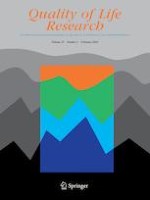13-11-2023
Quality of life in postmenopausal women with osteoporosis and osteopenia: associations with bone microarchitecture and nutritional status
Gepubliceerd in: Quality of Life Research | Uitgave 2/2024
Log in om toegang te krijgenAbstract
Purpose
Primary aim of the study was to investigate the status of different health-related quality of life (HRQoL) domains in postmenopausal women with osteoporosis and osteopenia, and to explore possible associations with bone microarchitecture and nutritional status.
Methods
This was a single-center cross-sectional study that included 232 postmenopausal women, from which they were divided into three groups—osteoporosis (OP, N = 63), osteopenia (OPIA, N = 123), and control group (N = 46). Detailed medical history data and anthropometric measurements were taken from all women. Bone structure parameters were taken with DXA device, with additional analysis of bone microarchitecture status with Trabecular Bone Score (TBS). Nutritional status was assessed with Mini Nutritional Assessment (MNA) questionnaire, and HRQoL with Medical Outcomes Study Short Form-36 (SF-36) questionnaire.
Results
Nutrition evaluation analysis have shown that patients in OP group had significantly lower values of MNA score compared to the OPIA group and control group (P = 0.005). Furthermore, a significant positive correlation was found between all of the SF-36 domains and MNA scores, while significant positive correlation was found between TBS values and Physical functioning (P < 0.001), Bodily pain (P = 0.027), Social functioning (P = 0.029), and Vitality domains (P = 0.041) in total investigated population. Further analyses were performed only in OP and OPIA groups, and TBS score showed significant positive correlation with Physical functioning (r = 0.248, P < 0.001) and Bodily pain domains as well (r = 0.180, P = 0.014), while MNA score positively correlated with each of the SF-36 domains. Multiple regression models have shown that MNA score retained significant association with each SF-36 domains, and TBS value with Physical functioning (P = 0.003), Social functioning (P = 0.012), and Vitality domains (P = 0.014).
Conclusion
This study highlights the associations that TBS has with some domains of HRQoL in postmenopausal women with osteoporosis and osteopenia. Moreover, nutritional status could play a role in the complex interplay between TBS and HRQoL.
